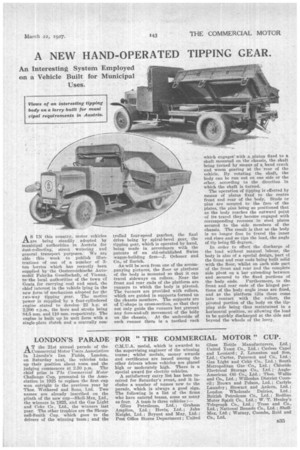A NEW HAND-OPERATED TIPPING GEAR.
Page 61

If you've noticed an error in this article please click here to report it so we can fix it.
An Interesting System Employed on a Vehicle Built for Municipal Uses.
AS IN this country, motor vehicles are being steadily adopted by municipal authorities in Austria for dust-collecting, street watering and general transport purposes. We are able this week to publish illur trations of one of a number of 3ton lorries which has recently been supplied by the Oesterreichische Automobil Fabriks Gesellschaft, of Vienna, to the local authorities of the town of Gratz for carrying coal and sand, the chief interest in the vehicle lying in the new form of mechanism adopted for the two-way tipping gear. The motive power is supplied by a four-cylindered engine stated to develop 22 h.p. at 2,200 r.n.m., the bore and stroke being 84.5 mm. and 110 ram. respectively. The engine is built up in unit form with a single-plate clutch and a centrally con
trolled four-speed gearbox, the final drive being by spiral-bevel gear, the tipping gear, which is operated by hand, being made in accordance with the patents of an old-established Swiss wagon-building firm—J. Ochsner and Co., of Zurich.
As will be seen from one of the accompanying pictures, the floor or platform of the body is mounted so that it can travel sideways on rollers. Near the front and rear ends of the platform are runners to which the body is pivoted. The runners are provided with rollers, which are guided in supports formed on the chassis members. The suPports are of U-shape in cross-section, so that they not only guide the runners but prevent any fore-and-aft movement of the belly on the chassis. At the underside of each runner there is a toothed rack
which engages' with a pinion fixed to a shaft mounted on the chassis, the shaft being turned by means of a hand crank and worm gearing at the rear of the vehicle. By rotating the shaft, the body can be run out on one side or the other, according to the direction in which the shaft is turned.
The operation of tipping is effected by means of plates fixed to the centre front and rear of the body. Studs or pins are secured to the face of the plates, the pin's being so positioned that as the body reaches the outward point of its travel they become engaged with corresponding recesses in steel plates secured to the side members of the chassis. The result is that as the body is no longer free to travel the inner end rises and so tips the load, the angle of tip being 65 degrees.
In order to effect the discharge of the load without manual labour, the body is also of a special design, part of the front and rear ends being built solid with the floor, whilst on each side part of the front and rear and the complete side pivot on a bar extending between and secured to the fixed portions of the body ends. Furthermore, to the front and rear ends of the hinged portions of the body angle irons are fixed, and as the platform tilts these come into contact with the rollers, the pivoted portion of the body on the tipping side being thus maintained in a horizontal position, so allowing the load to be quickly discharged at the side and beyond the wheels of the lorry.




















































































































